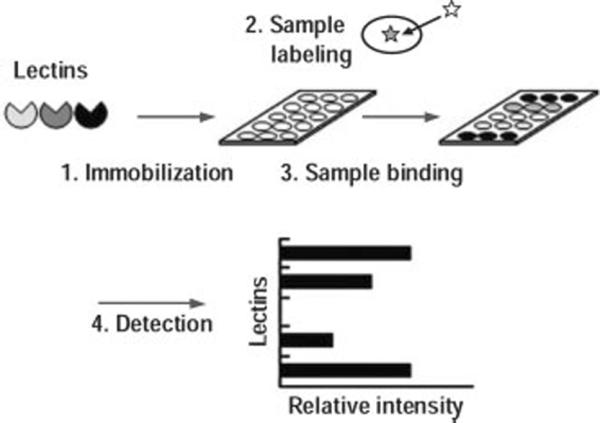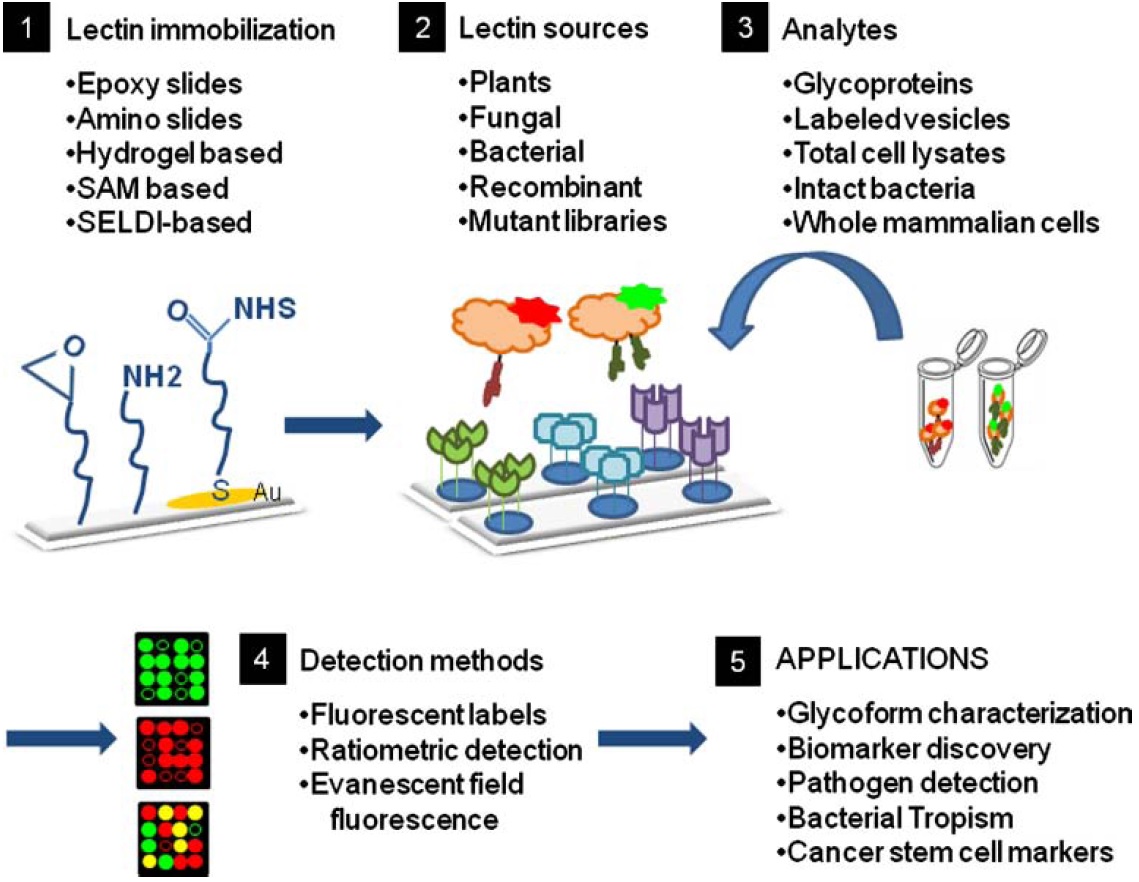Lectin microarray is a novel lectin-based glycan profiling method developed in 2005. It is a new platform that utilizes a panel of lectins immobilized on well-defined solid surface for high-throughout analysis of glycans and glycoproteins. Lectin microarray can estimate an entire feature of glycosylation of glycoproteins and cells through biochemical interaction analysis between the analyzed glycan and multiple lectins. It is one of the most sensitive, rapid and high-throughput profiling methods, which enables multiple lectin-glycan interaction analyses simultaneously. The most attractive advantage of lectin microarray is that it has the extremely useful property of direct applicability to glycans in both pure and crude forms (typically clinical samples such as sera and tissue extracts) of glycoproteins. Lectin microarray has been recognized as a unique method to analyze glycosylation feature of diverse glycoproteins.
 Figure 1. Schematic diagram of lectin microarray assay
Figure 1. Schematic diagram of lectin microarray assay
The general strategy for lectin microarrays involves immobilizing lectins onto solid surface, glycan or glycoprotein sample labeling, sample binding to lectins, and detections. There are various methods for lectin immobilization, including carbine insertion, biotin-avidin bridge, attachment of amine functional group of lysine side chains of protein-backbone of lectins for immobilization to solid surface through epoxy-functionalized or N-hydroxysuccinimidyl (NHS)-derived esters, and 3D hydrogel surfaces. The lectin sources can vary from bacterial, fungal, plant to synthetic, recombinant mutantlibraries depending on the purpose of the lectin microarray assay. The glycoconjugates for binding can be from a diverse set of analytes of biological samples, including glycoproteins, total cell lysates, intact bacteria, and even the whole mammalian cells. The glycans or glycoproteins are usually labeled with fluorescent probes. The dominant detection scheme in lectin array-based assays is the fluorescence detection. The ratiometric approach based on two-color labeling is also employed in lectin microarray detection for differential profiling of cellular glycomes. The lectin microarray based on an evanescent-field activated fluorescence detection enables specific detection of fluorescently labeled glycans or glycoproteins without any washing process and enables liquid-phase observation in an equilibrium state.
 Figure 2. Summary of lectin microarray technologies
Figure 2. Summary of lectin microarray technologies
As a sensitive and high-throughput technology for glycan analysis, lectin microarray has become a promising approach in glycomics and glycoproteomics. It can provide rapid analysis of glycosylation profiles of glycoproteins and glycoform characterization. It is also a useful approach for quantitative analysis of lectin-glycoprotein interactions. Through comparative microarray analysis, structural differences can be detected as the changes in signal patterns of the lectin-binding intensities. As a result, lectin microarray is a valid method for quality control of various glycoprotein products (such as antibody drugs), and differential analysis of appropriate clinical samples for the discovery of useful glycan-related biomarkers. Lectin microarray also has the potential for profiling of bacterial cell-surface glycans and the mammalian cell-surface glycome.
As one of the leading companies in the omics field with over years of experience in omics study, Creative Proteomics provides lectin microarray assay customized to your needs.
How to place an order:





